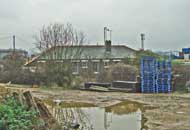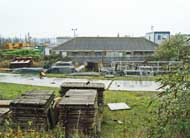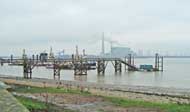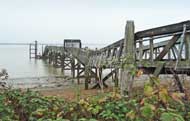Kent DA12 2QE
Infectious diseases
Prior to the Public Health Act, 1872, ships entering British ports were held in quarantine until they had been inspected and cleared of bringing in cholera, plague, yellow fever or other quarantinable infectious disease. The Act enabled Port Sanitary Authorities to be established; the City of London Corporation undertook this responsibility for the Port of London.
The district covered by the Port of London Sanitary Authority included the whole of the Tidal Thames from Teddington Lock in the west - a distance of 94 miles - including the lower course of the River Medway.
In 1883 the Corporation built an isolation hospital for sick and quarantined seamen at Denton, in Gravesend, Kent. (Although there were some 30 riparian authorities in London, none had made provision for sea-borne infections.)
The Hospital, known variously as the Port of London Sanitary Hospital, the Port Sanitary Hospital and Denton Isolation Hospital, opened in April 1884. It was believed to be the only hospital of its kind in the country. Neither the patients nor the ship owners were charged for the care and treatment.
Quarantine continued until 1889, when the Infectious Diseases Prevention Act was passed, giving medical officers the authority to board and inspect the ship's crews and passengers. The Act also introduced regulations to deal with cholera, yellow fever and plague. Vessels arriving from a foreign port (most European ports were exempt) were subject to inspection. Any persons with an infectious disease were removed, together with their belongings and bedding, and taken by launch to Denton (a pier and pontoon were added later to the site, so that the Hospital was accessible at all stages of the tide).
In 1905 some 36 patients were treated at the Hospital. A Samaritan Fund was set up to help destitute seamen whose clothes and possessions had been destroyed during the disinfection process.The Hospital was maintained by the Port Sanitary Authority (whose title was changed to the Port Health Authority by the Public Health (London) Act, 1936) and funded by the Corporation of London from its corporate funds until 1920, when its costs were defrayed by the rates and an Exchequer grant.
The hulk Hygeia, moored off Gravesend since 1922, from which all incoming ships were inspected, was used as a quarantine station and a base for the launches. She also contained accommodation for the boarding medical officers, who provided a service 24 hours a day. (The wooden ship was replaced in 1935 by an Admiralty lighter made of steel which had been built in 1918. She was renamed the Hygeia.)
During the 1930s the Hospital was enlarged and, by the end of the decade, consisted of various one- and two-storey buildings. The administration block also contained the Medical Officers' quarters, 12 rooms for the nurses (including one for Matron), and accommodation for the kitchen and laundry staff. The wards consisted of a cubicle block with 8 cubicles, each for two patients; a typhoid block of two wards - one with 18 beds and one with 6 beds; and a smallpox block of two wards with 6 beds each for sea-borne cases of smallpox, with accommodation for two nurses. The disinfecting station contained two baths and three showers, with a laundry and equipment for steam disinfection. A caretaker's cottage and an outbuilding for the gardener's stores completed the campus. The staff employed were a part-time Medical Officer, a Matron, 3 nurses, a cook, 4 maids, a caretaker, a laundress and a gardener. The Hospital was normally under the control of the Deputy Port Medical Officer of Health.Between 1930 and 1936 about 50 to 60 patients a year were admitted. In 1930 the cost of keeping an in-patient for one day was £4 6s (£4.30). (The small number of in-patients resulted in high overhead charges per patient. Costs in local authority hospitals which received seamen from the river or docks on behalf of the Port of London were about 11s (55p) a day.) In 1931, 52 patients were admitted, with a cost of £7 16s (£7.80) a day per patient. The following year there were 53 patients, at a cost of £5 10s (£5.50) each a day. In 1937 there were 117 patients, costing £3 19s (£3.95) each a day and, in 1939, 209 patients at £2 4s (£2.20) each a day.
The patients were not only seamen, but also passengers (male and female), dockers, stevedores and any others working ashore in the Port Health Authority's territory. Diseases treated included chickenpox, measles and German measles, diphtheria, smallpox (only 2 cases during the 1930s, in 1935), mumps, malaria, bubonic plague, typhoid, scarlet fever, enteric fever, dysentery, scabies, tonsillitis, pyrexia, septic throat, impetigo, hepatitis, colitis, angina, jaundice and eczema.
During WW2, the Hospital suffered serious bomb damage in 1940 and was closed for bed cases, although the disinfection unit remained open. In February 1942 the Admiralty requisitioned the site for use as a treatment centre for servicemen with venereal disease and parasitic infections (scabies). Two Nissen huts were built in the grounds for this purpose.
The Hospital reopened in August 1947, when it had 32 beds. In the same year the City of London Corporation applied for it to be disclaimed from the National Health Service on the grounds that it provided a unique service, while the Seamen's Hospitals did not admit women or dock workers, only professional sea-farers.
The application failed and the Hospital joined the NHS in 1948, grouped with the Seamen's Hospitals under the control of the South East Metropolitan Regional Hospital Board. The Corporation was entitled to appoint one member to the group's Hospital Management Committee.
In April 1953, when the Hospital had 40 beds, the Ministry of Health decided to transfer control of the Hospital to the Dartford Group Hospital Management Committee.
Patients were still brought to the Hospital by ambulance launch. The Medical Officers had various quarantine launches at their disposal - the Howard Deighton, the Alfred Roach, the Alfred Robinson and the Frederick Whittingham. The Humphrey Morris, bought in 1962, had a consulting room, with accommodation for two stretcher cases and three ambulant patients.
By 1966 the Hospital had 20 beds and, by 1971, 8 beds.
It closed in 1976. Services moved to Joyce Green Hospital.
Present status (November 2009)
The site is somewhat derelict and not much remains of the former Hospital. One of the buildings is in use as the Denton Quarantine Station.


One of the original one-storey Hospital buildings on the eastern side is still occupied (left). Another one-storey building on the western side is derelict (right).


The pier is no longer used.


The view to the east (left) and to the west (right).
Today the London Port Health Authority employs a Consultant in Communicable Disease Control who heads a team which is available 24 hours a day to board ships and aircraft and which can implement control plans and emergency measures. There are also Port Health Inspectors, all qualified environmental health officers, who are available 24 hours a day to inspect ships and aircraft. The infectious diseases have changed somewhat and now include TB, SARS, HIV, noroviruses and food poisoning.
The Authority owns two 50-ft long launches and three rigid inflatable boats, used to transport the medical officers to ships at anchor or to meet arriving vessels.
All ships arriving from a foreign port must possess a Ship Sanitation Control Certificate. This has replaced the Deratting Certificate which proved that the vessel was rodent-free, thus eliminating the possibility of plague being brought into the country.
(Author unstated) 1935 The medical ship 'Hygeia'. British Medical Journal 2 (), 30th November, 1066.
(Author unstated) 1948 Port of London Ambulance Launch. British Medical Journal 2 (4580), 721.
Averns J 2006 Frontline infectious disease control at Britain's borders. Lecture given at Gresham College.
Maglen K 2002 'The first line of defence': British quarantine and the Port Sanitary Authorities in the nineteenth century. Social History of Medicine 15, 413-428.
Williams H 1904 The health of the Port of London. British Medical Journal 1 (2263), 1144.
Wright Mason J 1919 What is a systematic inspection of a ship? Journal of the Royal Society for the Promotion of Health 40, 223-224.
http://hansard.millbanksystems.com
www.aim25/ac/uk
www.cityoflondon.gov.uk
www.dartfordhospitalhistories.org.uk
www.kenthistoryforum.co.uk
www.portcities.org.uk
Return to home page